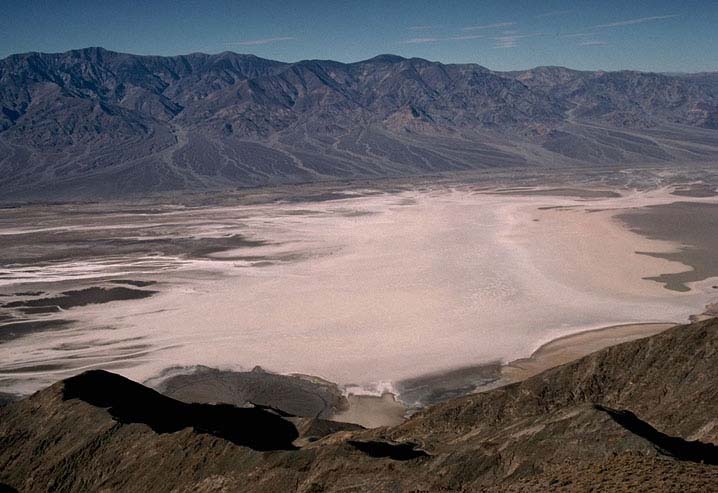Views from Dantes View. (well,
near Dantes View)
The floor of Death Valley tilts gently eastward. From here, one
can see that the alluvial fans on the west side of the valley are far larger
than on the east side. This difference results partly from the eastward
tilting of the valley floor. On the west side, alluvial material spreads
laterally and extends far onto the valley floor because it accumulates
on a surface that is gently inclined away from the range; on the east side,
the material becomes trapped near the mountain front because it accumulates
on a surface that is inclined gently towards the mountains.
 Death Valley Salt Pan as
seen from Dantes View. Looking west. Note the difference in size
of alluvial fans on the west side of the valley when compared to those
on the east side. The fans on the east side are much smaller because the
valley floor tilts gently eastward.
Death Valley Salt Pan as
seen from Dantes View. Looking west. Note the difference in size
of alluvial fans on the west side of the valley when compared to those
on the east side. The fans on the east side are much smaller because the
valley floor tilts gently eastward.
By contrast, when looking east...

It's so steep on the west side because the fault zone which uplifted
the mountains is on the west side. During movement on the fault, the Black
Mountains rotated eastward--so in the view immediately above, you are looking
essentially at the top of the rotated block.
Further evidence for the tilt of the valley floor comes from observations
by Hunt and Mabey (1966). They noted that zonation of minerals on the salt
pan reflects tilting and that shorelines from Lake Manly tend to be higher
on the west side of Death Valley than east side.
This eastward tilting of the Black Mountains, the Panamint Range, and
the floor Death Valley typifies much of the Basin and Range Province. Through
crustal extension, the region broke into a series of tilted fault blocks.
In general, these blocks tilted away from the faults along which they rose
and towards the faults along which they sank.
 Death Valley Salt Pan as
seen from Dantes View. Looking west. Note the difference in size
of alluvial fans on the west side of the valley when compared to those
on the east side. The fans on the east side are much smaller because the
valley floor tilts gently eastward.
Death Valley Salt Pan as
seen from Dantes View. Looking west. Note the difference in size
of alluvial fans on the west side of the valley when compared to those
on the east side. The fans on the east side are much smaller because the
valley floor tilts gently eastward.